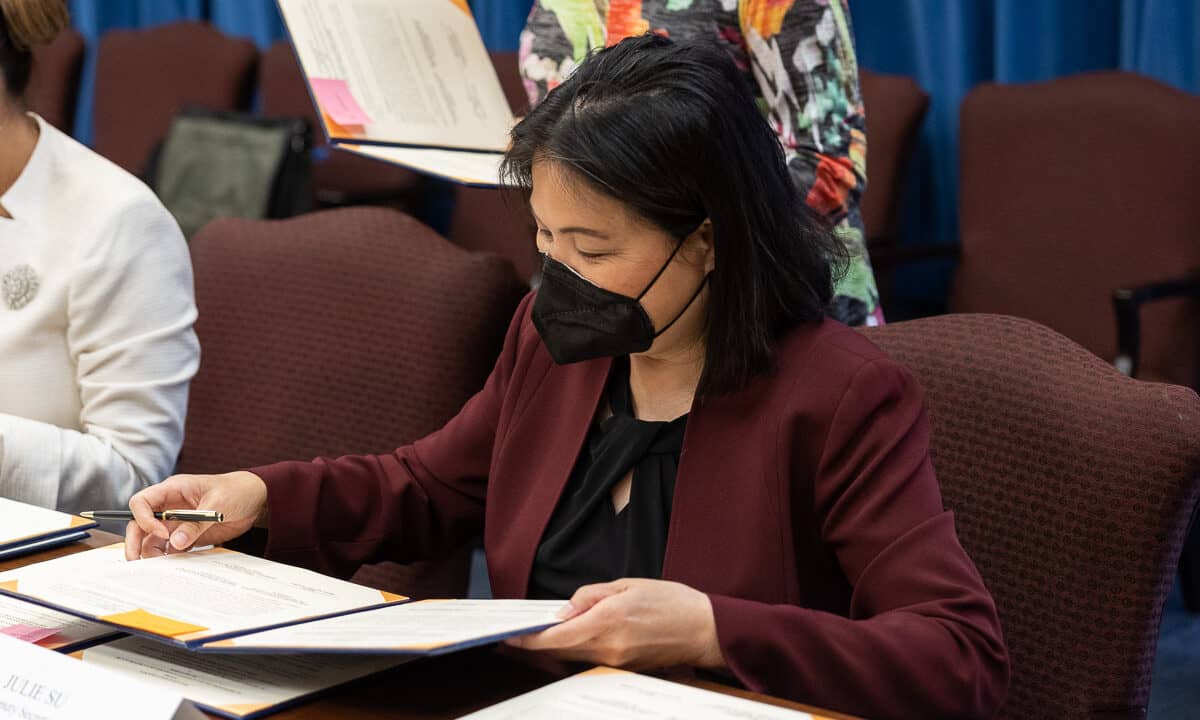 Photo by US Department of Labor on Flickr is licensed under CC BY 2.0: https://bit.ly/3ZPiUvR
Photo by US Department of Labor on Flickr is licensed under CC BY 2.0: https://bit.ly/3ZPiUvR
In a recently unearthed essay, President Biden’s nominee for Secretary of Labor, Julie Su, endorsed Critical Race Theory (CRT) and railed against “colorblindness and individuality.”
Su emphasized that Critical Race Theory can be a way to “productively explore” how to “explode the constricted, colorblind civil-rights paradigm.”
Su, who has been the U.S. Deputy Secretary of Labor since 2021, co-authored the essay with Eric K. Yamamoto, Professor of Law and Social Justice at the University of Hawaii at Mānoa. It was published as part of the 2002 book Crossroads, Directions, and a New Critical Race Theory.
The summary of the book on its Amazon listing describes the collection of authors including Su as “31 CRT scholars” who “present their views on the ideas and methods of CRT, its role in academia and in the culture at large, and its past, present and future.” Within the essay, Su further describes herself as “a front-line civil-rights lawyer who is also engaged in race and coalitional theory development.”
Here are some excerpts from Su’s essay:
“Critical Race Theory might also productively explore how critical coalitions explode the constricted, colorblind civil-rights paradigm.”
“The attack by some that Critical Race Theory is about race, power, and politics but not about law tells us that it is law––or, more specifically, how we traditionally do law––that needs to change.”
“The current paradigm by which civil-rights struggles are conceived and debated––a devotion to colorblindness and individuality––constricts and at the same time requires the productive framing and handling of coalitional claims against dominant white interests.”
“In what ways can race scholars and political lawyers, working together, contribute to a progressive social-justice movement? What is our role, not only in the academy and the courts, but also in neighborhoods, schools, workplaces, churches, city councils, and legislatures?”
“For poor, non-English-speaking, documented and undocumented women of color, compassion, dignity, rights, and equality––even in the United States––are not givens. They are not even necessarily ‘the law.’”
“When multiracial communities are fighting white racism and when mainstream America subconsciously acts on race in myriad daily decisions, can racism be fought without acknowledging both racial diversity and convergence? And if multiracial color-consciousness adds power, richness, and depth to coalitions, should we not encourage deeper understanding of one another not only as individuals but also as members of racial communities?”
“Critical Race Theory writing has begun to explore the new multifaceted coalitions. It has pioneered the concept of intersectionality to explain the confluence of race, class, gender, and sexual orientation and the law’s often hidden contribution to the maintenance of interconnecting forms of social oppression.”
“In this fashion, Critical Race Theory and its related schools have provided a framework for diverse alliances to combat the anti-affirmative-action assault.”
“Sweatshop owners are often Asian immigrants eking out a living in the face of downward pressures imposed by manufacturers and retailers. For this reason, Latina workers view Asians generally not as friends or even strangers, but as enemies––the very source of their daily subjugation. Owners and executive officers of large corporations, who are primarily white, appear to remain above the fray… In this way, individual decisions are entrenched, interracial group hostility solidified, and white corporate racism absolved.”
“Unrelenting conservative attacks by Republican presidents, legislative majorities, and federal and state judges on civil rights, affirmative action, and desegregation, with the complicity and active participation of so-called liberal leaders and Democratic Party members, have rolled back many civil-rights gains.”
The essay also cites a speech given by Julie Su at the “Critical Race Theory Conference” at Yale University Law School in 1997, when she encouraged her fellow CRT scholars:
“Make your theories into arguments that stand up in court and into foundation proposals that will get us funding for front-line activism… talk about front-line activism and in-your-face street work in your conferences, faculty meetings, classrooms and give your students opportunities to do them.”
Read the full essay by Julie Su here.

